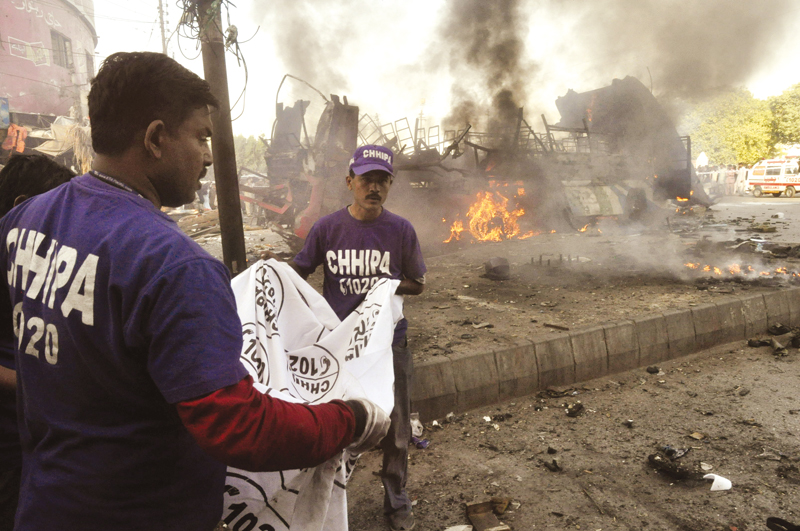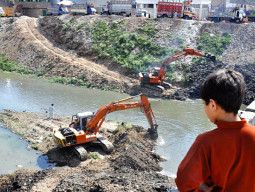
KARACHI:
Karachi is no novice when it comes to bomb blasts. They have almost become a regular occurrence in the city. Each tragic incident brings with it the customary news flashes, the ambulance sirens, the high alert in hospitals and the rhetorical condemnations of state and government officials.
This story is not about the farce cries of pity though. Neither is it about the lives of the families who have lost their bread-winners in such incidents. This story is about those who have come to terms with death and are no longer repelled by the gory scenes of blood and despair in the aftermath of a blast.
These are the rescue workers who drive around in their ill-equipped vehicles that are passed off as ambulances in the city. They are largely employed by charity organisations such as Edhi and Chhipa and are the ones who usually clear up the mess of the blast site. The police cordon off the site; the politicians sometimes appear to condemn; the bomb disposal squad scans the site for more explosives. It is only after these formalities are dispensed with that rescue workers begin the most menial job of the ordeal: collecting the scattered remains of the victims.
For the layperson with a not-so-strong stomach, simply the sight of the bloody organs may be enough to spill the contents of the stomach. The rescue workers, however, get down to the task each time, picking up the almost indiscernible human remains and depositing them in white cotton sheets. More often than not, the body parts are unrecognisable and will be buried as unidentified.
They sweep the ground inch-by-inch, collecting each piece of human flesh from the site, the nearby buildings and even from the trees, making it possible for the forensic experts to examine the nature of the blast. The role of forensic experts comes much later.
In developed countries, such crime scenes are scanned thoroughly and the evidence is collected by trained personnel employed by special crime scene-cleaning companies. These professionals don full-body suits, scanners and oxygen masks and are required to store each and every piece of evidence in a standard manner.
Unfortunately, the Edhi and Chhipa volunteers lack such equipment. They go about their jobs without any masks, their clothes often stained with human blood.
Every rescue worker has dozens of moving stories to tell about their experiences in collecting and transporting the ripped-apart human bodies. They have managed the city’s most devastating blasts - the Nishtar Park blast on October 18, the Karsaz blast, the Chehlum blast at Light House and the brutal attack on Abbas Town.
Forty-three-year-old Muhammad Asif Khan has been volunteering for the Chhipa welfare organisation for the past 20 years. “We have no training for the job but I don’t think you need it. What you really need is courage and passion to do the job,” he said. “I still can’t forget those moments when people were screaming and running like crazy and human chunks of human flesh were stuck to the walls,” he said, speaking about the Karsaz blast. Admittedly, it has taken him a long time to come to terms with the requirements of the job. “When I initially started the job, I used to have horrible nightmares. But you eventually reach a point when your senses adapt to the nature of the job.”
An Edhi driver, 51-year-old Shahid Khan, has become a crime scene expert of sorts, due to his 22-year experience in the field. “Our first priority is to shift the injured to hospital. The bodies are then shifted to the morgue and in the end, we started collecting the remains,” he explained. Referring to the suicide attack on former President Asif Ali Zardari’s chief security officer, Bilal Shaikh, he said that he had found the alleged suicide bomber’s head from the rooftop of the five-storey building located near the blast site.
While the rescue workers are picking up the debris, the police do their work on the sidelines; managing the onlookers, preserving the scene of crime, lifting finger prints and photographing the site.
“After rescuing the injured, our first priority is to keep away the onlookers and give way to the bomb disposal squad,” DIG Tahir Naveed told The Express Tribune. “We also collect the remains for DNA analysis.”
After being examined at the hospital, the remains are shifted to the Edhi morgue for DNA testing. “We preserve the remains as the law enforcement agencies have to perform DNA tests,” said an Edhi employee, Anwar Kazmi. “The maximum time we store the remains is two months. After that, we bury them in the Edhi graveyard.”
Published in The Express Tribune, August 25th, 2014.





























































COMMENTS
Comments are moderated and generally will be posted if they are on-topic and not abusive.
For more information, please see our Comments FAQ